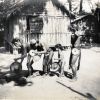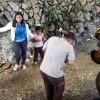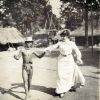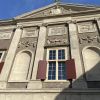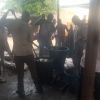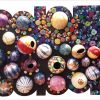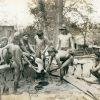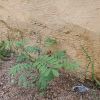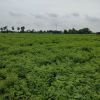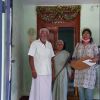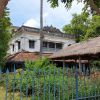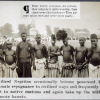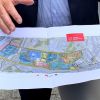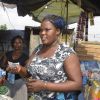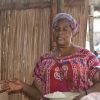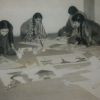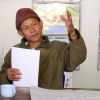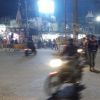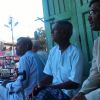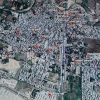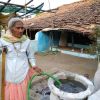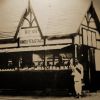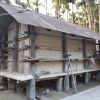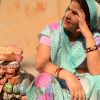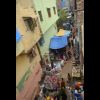The search found 108 results in 0.022 seconds.
Search results
In this photograph from the Missouri Historical Society archive, titled by author Jessie Tarbox Beals (1870-1942) as “As God made them… Pierre Chouteau”, it depicts 4 Bontoc Igorot (an ethnolinguistic group of indigenous Filipinos from the Cordillera region of the Philippines) boys as they dance what is most likely the Ballangbang, a cultural dance performed during mass celebrations and social gatherings.
Attached here is an archival photograph from the Missouri Historical Society of the 1904 St. Louis World’s Fair, specifically of indigenous Filipinos from the Cordillera region of northern Luzon known as the Igorots. Titled by American photographer Jessie Tarbox Beals (1870-1942) as “Mrs. Wilkins teaching an Igorrote boy the cakewalk at the 1904 World’s Fair,” the photographs presents two people in the image, the eponymous young Igorot boy dancing with Vienna opera singer Mrs. George S. Wilkins, as she teaches him the cakewalk, a popular dance of the time period.
This image is of the front edifice of the Museum de Lakenhal in Leiden, NL. Carved in the facade are representation of the spinning, weaving, and dyeing process for the historic laken textile produced in Leiden in the Early Modern Era. Through paintings of textiles and their production and the museum is dedicated to telling the history of the laken textile process that was historic to Leiden for centuries until production was halted in 1979.
Field Work to Bulamari Local Dyeing Centre, Maiduguri, Borno State.
Bulamari Dyers are the Kanuri speaking indigenes of Maiduguri, Borno State. They Specializes in the production of the Kanuri tie and dye attires, especially the Kanuri blue and black fabric known as “Dongashou”.
The findings of the survey carried out at Bulamari Dyeing Center, behind the Shehu Palace in Maiduguri, Borno State are as follows:
Beauty is the quality present in a thing or person that gives intense pleasure or deep satisfaction to the mind, it can also be a combination of qualities, such as shape, colour, or form that pleases the aesthetic senses, especially the sight.
In 1904, the United States introduced Filipino culture to the American public with their Philippine Exposition at the St. Louis World’s Fair, a faux recreation of indigenous Filipino villages located at the outskirts of the exhibition fairgrounds and populated with various indigenous Filipino tribes from across its various islands, the most well-known being of the Ifugao people of northern Luzon, referred to at the time as Igorots (Taft, 1904, 29-30).
Indigo is popular globally for its usage in the dying industry. But locally a particular species of indigo has been famous among the farmers of Tindivanam town in Tamilnadu as green manure.
Neela thotti/ thotti is the tamil colloquial term that refers to the avuri (indigo) wet leaf production tank. The existence of a number of thottis in a region implies the range and scale of cultivation and production of indigo. Before the 90s in the northern part of Tamilnadu, India, indigo was cultivated on a large scale for indigo cake production with numerous thottis. The development of synthetic dyes affected the market value of natural dyes.
In this photograph taken by American photographer Jessie Tarbox Beals (1870-1942), are eight Negrito young men at the 1904 World’s Fair in St. Louis with a statue of King Louis XIV in the background. As they are in an open field, this photograph could have been taken during the “Anthropology Day” games held by the fair committee to show off the indigenous Filipinos’ skills in various sports games to the public. In this case, the boys would have shown off their skills with a bow and arrow, whose straps can be seen over their shoulders.
Leiden Bio Science Park was founded in 1984 at the west of the Leiden Central Train Station which is the largest and fastest-growing science assemblage in the Leiden. The 2km wide campus includes housing, a university, a hospital, restaurants, a sports center, business companies, and many others. In the photo, it mentions the model of Bio Science Park which is proposed to be set up as a lively campus.
The traders here accept all the three West African Currencies for transactions (CFA, Niara, Ghana Cedis). Irrespective of whichever currency a buyer offers, the shopkeepers are able to convert and give change when required. It is interesting how they (shopkeepers) are not limited in anyway among themselves despite the physical border restrictions.
Bhagat Singh Library and Cultural Centre (1983-1990) was an initiative of a grassroot organisation called Kishore Bharti in Pipariya, Madhya Pradesh. The Library/Centre focused on creating social awareness through reading, writing and community based activities. While the library started as a space for all the sections, a need was soon felt to add a separate slot to encourage women readers. In the following excerpt, Rekha Vyohaar, a resident of Pipariya, shed light on how the setup was significant to the women at the local level:
Pati Preecha Siri is regarded as a very respectful elder among the villagers of Hin Lad Nai community. He was honoured by the United Nations, on April 10th 2012, at Istanbul, Turkey, with the “Forest Hero Award” for the the whole community's work in protecting and preserving the forest. There were only five people selected to receive the award from 47 people and 30 countries around the world, and Pati Preecha was the one selected from Asia.
“The tea and snack joints at Mangalwara Chowk have always been very integral to the town of Pipariya. During the 1950’s and 60’s, there were two very popular joints here. One of them was called ‘Bharat Hotel’ and belonged to a Sindhi fellow. Sindhis came to this town after partition and set up small scale confectionary shops. The other one was run by Mr. Shyam Jaiswal. These joints were the hubs of all the political and social gossip in the town.
A Google map representation of the town of Pipariya situated in Madhya Pradesh, India. The map is marked with 25 local neighbourhoods (names in Hindi script Devnagri) that were an often-recurring reference point in the oral narratives recorded with the residents of the town. Highlighting the politics of everyday spaces, the map can be considered a visual marker of a settlement where some places are more or less relevant than others.
Suman Bai Goojar is a resident of Puraani Basti, one of the oldest settlements in the town of Pipariya, Madhya Pradesh. Hailing from the semi-nomadic pastoral Goojar community, hers is a narrative where fields are connected to pastures and communities to spaces. A snippet from our recorded conversation:
Pipariya Railway Station in district Hoshangabad, Madhya Pradesh, India was primarily established as the railhead for the Military Cantonment town of Pachmarhi. The present excerpt narrates the politics of everyday spaces at the station in the initial days. The excerpt has been translated from Hindi (Text: Pipariya, 2000 by Narayandas Maurya). The picture is only for representation purposes.
Kaushalya has been selling laces in the Saturday weekly street market in Shadipur, West Delhi, for over 10 years. She is one of the very few women street vendors who make a living by selling various products across weekly markets in Delhi. In Shadipur Shani Bazaar, of the 350 plus street vendors only 10-12 of them are women.
The Shadipur Shani Bazaar, known for the cheap and affordable stitched and pre-stitched fabric it offers, is one of the main attractions of the Shadipur neighbourhood. Spread entirely by word of mouth, the low prices at the market attracts customers from other parts of West Delhi, India. Hi-end boutique owners from Karol Bagh come here as well to buy fabric and bling to accessorise their products.
According to Bobby, a resident who sells children’s clothes in the market,
Pages

